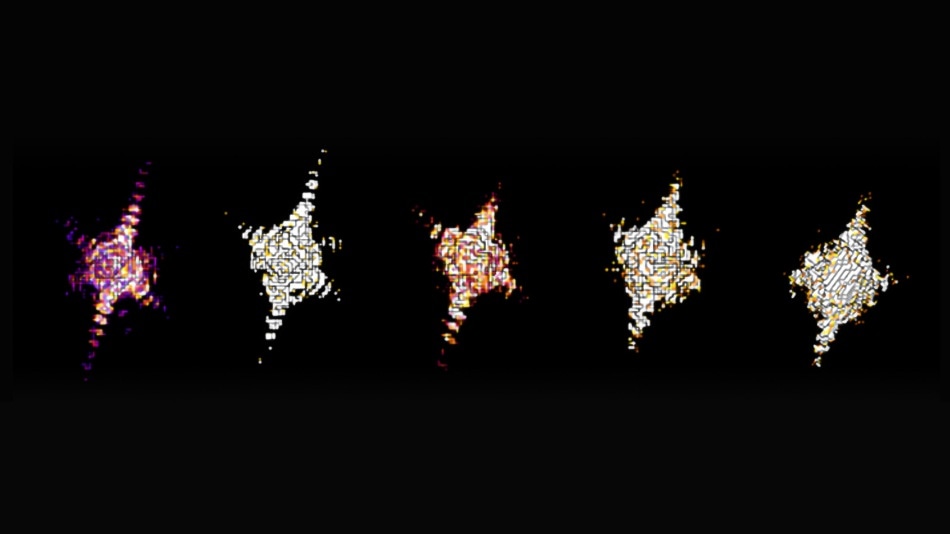Mar 7 2019
Observing the way minerals react in diverse conditions can provide geoscientists a significant amount of information regarding the properties of the materials that constitute the world.
 Argonne researchers used coherent X-ray diffraction imaging to look at the strain inside an iron nanoparticle as it oxidized. This image shows the nanoparticle gradually oxidizing. (Image credit: Argonne National Laboratory.)
Argonne researchers used coherent X-ray diffraction imaging to look at the strain inside an iron nanoparticle as it oxidized. This image shows the nanoparticle gradually oxidizing. (Image credit: Argonne National Laboratory.)
In certain cases, fascinating properties and results can be obtained by simply exposing minerals to water-based surroundings.
In a recent study, researchers from the U.S. Department of Energy’s (DOE) Argonne National Laboratory placed tiny particles of iron oxide in an acidic solution, promoting the oxidation of iron atoms on the particles’ surface. As the reaction continued, the scientists noticed strain that accumulated and entered into the mineral particle.
Argonne physicist Paul Fenter informed that the type and degree of strain are governed by the shape of the particles.
When we look at how things react, we are not typically worrying so much about the shape or morphology of the material. In this case, we have a result in which the spatial distribution of reactivity within the particle is not uniform, which we think is ultimately controlled by its size and shape.
Paul Fenter, Physicist, Argonne National Laboratory.
While studying the particles of iron oxide, also called magnetite, Fenter and his coworkers noticed the formation of hematite—a reaction that starts at the surface of particles.
“Essentially, what’s happening is that we’re changing from one kind of rust into a different kind of rust,” stated Ke Yuan, the first author of the study and postdoctoral researcher.
While looking at the changes in the particle induced by the oxidation, the researchers noticed strain that entered deep within the material and also observed the appearance of isolated defects.
We’re moving away from an understanding of these reactions as happening uniformly in one big clump of material toward a more sophisticated understanding of how the particle shape and morphology can alter and influence how a reaction proceeds.
Paul Fenter, Physicist, Argonne National Laboratory.
“Even though these particles are all magnetite, they all react in somewhat different ways, and so this is a challenge for understanding how reactions proceed in systems where you have different micro- and nanostructures of the particles,” added Yuan.
In order to detect the distributions of strain inside the material, the scientists applied a method known as coherent diffraction imaging (CDI), which enabled them to look into the material’s atomic lattice. With the help of the CDI technique at Argonne’s Advanced Photon Source (APS), a DOE Office of Science User Facility, the team successfully detected a slight reduction in the lattice spacing—less than 1%—caused by iron oxidation. This tiny difference in the lattice spacing was distributed non-uniformly all through the particles of iron oxide; according to the scientists, this may be responsible for producing the defects observed by them.
The APS’s ability to provide brilliant coherent X-rays makes it unique for this kind of experiment. By generating highly penetrating X-rays with substantial coherent flux, and then combining them with dedicated X-ray imaging instrumentation, we can map the internal structure and strain in materials in 3D with nanoscale spatial resolution and atomic sensitivity.
Wonsuk Cha, APS Beamline Scientist, Argonne National Laboratory.
Applying CDI to tangible and geochemically pertinent materials represents a step forward for the method, stated Fenter.
“What’s really novel about this work is that we’re doing it with geological minerals that can have irregular morphologies, as opposed to idealized particles with well-defined shapes,” he stated. “It’s a new application of these tools to understand how this behavior happens in nano-sized minerals.”
“It’s a good model system for natural systems,” added Yuan. “It gives us a good way to understand the reactivity of complex natural systems.”
Fenter elaborated that these findings may hold wider implications for the geoscience community. Prospective studies looking at the way ions adhere to the surface of a mineral could be influenced by strain, even when that strain evolves from the interior of the material, he stated.
An article based on the study, titled “Oxidation induced strain and defects in magnetite crystals,” has been published in the February 11th, 2019 issue of Nature Communications. Sang Soo Lee and Andrew Ulvestad are other Argonne authors. Bektur Abdilla and Neil Sturchio of the University of Delaware, and Hyunjung Kim of Sogang University in South Korea also contributed to the study.
The DOE’s Office of Science funded the study.